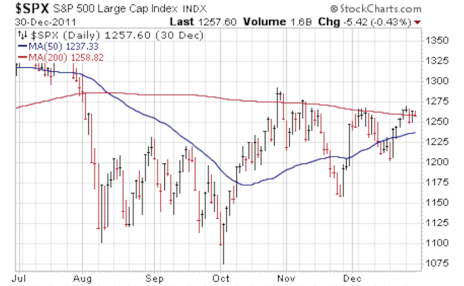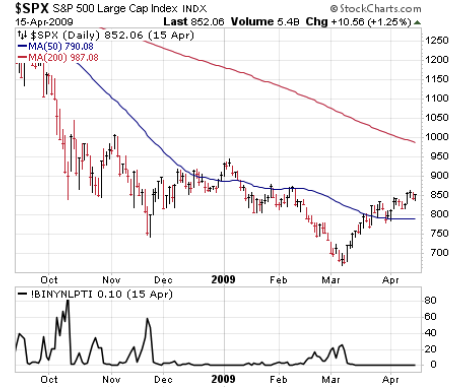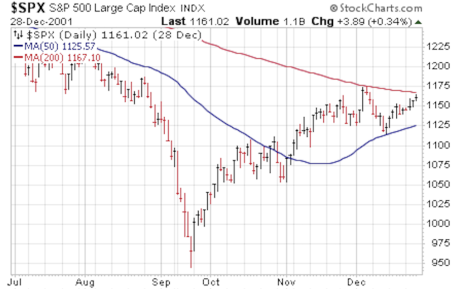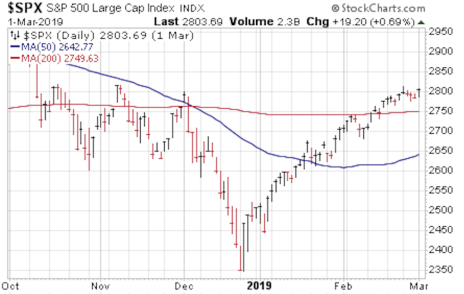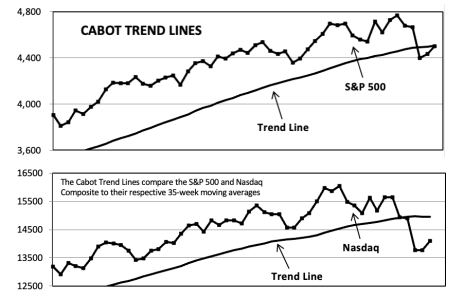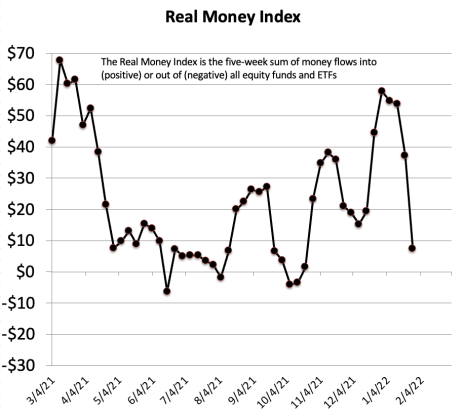Two weeks ago, we thought the market had likely hit (or would soon) a workable low--and that was right, with the major indexes and (more important to us) a good number of growth stocks perking up. It’s encouraging, but we can’t say we’re bullish yet: The trends of the market and growth funds are still down, and even things that have popped nicely aren’t set up quite yet. All in all, we’re sitting on our hands, but we’re also watchful--another few good days could change things, but at this point the odds still favor more time being needed as a bottom is built.
Market Overview & Model Portfolio Update
Encouraged—but Not Yet Bullish
In the last issue on this page, we wrote, “There’s also no question that we’re beginning to reach levels where a bounce is at least possible—what we think could be the start of a repair phase, where the best stocks of the next advance will start to repair the damage on their charts as big investors take positions.” And that’s exactly what’s happened, with a very solid rebound during the past two weeks and, most important to us, some wheat-separating-from-the-chaff action among individual growth stocks.
Barring a slew of rare blastoff indicators flashing green (which would definitely tell you we’re headed higher), the move has been about as good as the bulls could have hoped for—especially considering that, despite the rally in the indexes and a good number of earnings gaps, it seems like the crash phase (and well-trumpeted fears of inflation and higher interest rates) has dented investors’ psyche. The Investors Intelligence survey (the granddaddy of sentiment surveys) just saw the percent of bullish advisories reach a new recent low of 34%, with other measures also showing high levels of unease.
Put it all together and we’re encouraged—but that’s different than saying we’re bullish, at least at this point. Despite the solid action, it’s hard to argue any of the market’s major trends have changed: Our Cabot Tides are negative, the Growth Tides are in the same boat (actually a bit worse off), and even our longer-term Cabot Trend Lines are still in the red. Moreover, while a good number of commodity-related names look good, there are few, if any, real setups among growth stocks.
None of that is necessarily bearish. Indeed, it’s hard to expect a bunch of growth stock setups so soon after the crash-like moves we saw in many names. Plus, bottoms are usually a process, not an event (there are exceptions of course; see more later in this issue), so more time spent in the repair phase would probably be a good thing.
Having sat through the crash with a lot of cash, and watching the bounce back up, we we think the right move is to remain in a defensive posture—but we’re keeping our eyes open should things change. Right now, the market is approaching some key levels; another 3% to 5% (depending on the index or fund) on the upside could produce some green lights from our market timing indicators. If that happens, you can be sure we’ll follow along, but for now, a bit more patience makes sense.
What to Do Now
Keep most of your powder dry. In the Model Portfolio, we’re still sitting on our hands, with about two-thirds of our stake sitting on the sideline. If the market can shake off the current bad news (big inflation) and rally from here, we could do some buying, but we advise holding off any major buying spree until the market’s trends turn up and more growth stocks get going.
Model Portfolio Update
After a harrowing two-month decline for growth stocks, the long-awaited bounce is underway, and so far, it’s been good—the biggest moves have generally been amongst the most beaten-down names, with most indexes and growth funds rallying toward resistance (but not overcoming it, yet).
It’s been a solid couple weeks of improvement, but to this point, nothing has really changed with the overall evidence—our Cabot Tides and Growth Tides are still negative and would need another few percent upmove to change that in the near term. Moreover, our Cabot Trend Lines are negative as well—that’s not a precise timing tool, but we view it as another hurdle the market needs to overcome before we conclude a sustained uptrend is underway.
Of course, it’s not exciting to sit mostly in cash; none of us got into the stock market to sit around and do nothing. But right now the odds still favor a bottom-building process playing out in the weeks ahead ... though we’re open to changing our minds should the buyers flex their muscle from here.
The good news is that we’re quickly updating our watch list as some names pop on earnings or break out to new highs; we’re not that far from nibbling on a potential new leader or a strong, early-stage commodity stock. Tonight, though, we’ll again sit on our hands, letting the rally play out a bit longer while waiting for a rally confirmation.
Current Recommendations
| Stock | No. of Shares | Portfolio Weightings | Price Bought | Date Bought | Price on 2/10/22 | Profit | Rating |
| Arista Networks (ANET) | 1,626 | 10% | 137 | 12/10/21 | 127 | -7% | Hold |
| Devon Energy (DVN) | 7,240 | 18% | 28 | 5/7/21 | 52 | 85% | Buy |
| ProShares Ultra S&P 500 (SSO) | 1,741 | 6% | 30 | 5/29/20 | 65 | 116% | Hold |
| CASH | 1,423,520 | 67% |
Arista Networks (ANET)—Arista is reporting earnings next Monday (February 14) after the market closes, with sales expected to hit $789 million (up 22%) and earnings to reach 74 cents (up 19%). But as we’ve written, this is really about an expected acceleration in 2022 and beyond as the hyperscale players ramp spending—indeed, analysts see sales and earnings growth picking up steam this year (upper 20% range) despite some supply constraints. Despite its earnings hiccup, Facebook/Meta Platforms (one of Arista’s big customers) is basically confirming that an upgrade-related spending spree is coming; on its conference call, management reiterated its plans for a huge bump in CapEx this year, most for technology-related infrastructure, which is exactly what Arista’s networking offerings (including its operating system, which is the secret sauce) play into. As for the stock, it’s in decent shape: The bounce hasn’t been dramatic, but it has recouped around 40% of its decline, and at just 13% off all-time highs, it’s practically Herculean compared to most growth stocks. We’re optimistic that ANET, which only really changed character last October, can resume its leadership position during the market’s next uptrend, but let’s see what earnings bring—a very poor reaction could have us cutting bait, but we’re willing to allow the stock a good amount of leeway given its reasonable correction thus far. HOLD
Devon Energy (DVN)—Oil stocks have been a bit up and down in recent days. The fact that this comes even as oil prices are hanging around the $90 area, along with the group having become somewhat obvious to the crowd, makes us wonder if the sector could pull in a bit more—stocks often (not always) lead the commodity. Still, that’s pretty short-term stuff, as DVN and the leaders in the group are in fine shape, mostly trending higher above their 25-day lines. While the group’s uptrend won’t last forever, it certainly still appears that investors aren’t discounting ever higher oil prices—if anything, stocks like DVN seem to be pricing in a $10 to $15 drop in oil. At $75 oil and $3.75 natural gas, this company’s free cash flow (after all CapEx) should total something like $6.30 per share this year, with a ballpark estimate of $3.50 paid out in dividends, plus 3% of shares bought back with the rest going to debt reduction. Of course, you can analyze all the numbers all you want—DVN, the sector and market are going to do what they’re going to do, so if we see a major bout of abnormal action, we would likely trim our position given our good-sized stake and big profit. But at this point, we’re comfortable just holding on and seeing what comes with next week’s quarterly report, due February 15. Given that energy prices were higher in Q4 than Q3, expectations are likely for a dividend at least as big as last quarter (which, adding the fixed portion and variable portion, came in at 84 cents per share), while all other details or updates to the shareholder return plan will likely move the stock. As always, we’ll just take it as it comes—right here, DVN is probably one of the top stocks in the market, so we’ll stay on Buy, though pullbacks are best when picking up shares. BUY
ProShares Ultra S&P 500 Fund (SSO)—Honestly, if you’d have told us we’d own a stake in a leveraged long index fund when our Cabot Tides and Cabot Trend Lines are both negative, we’d have never believed you—but here we are, hanging onto SSO, as the S&P 500 remains one of the strongest major indexes (SSO is “only” 10% off its peak and above its 200-day line). Now, if you own SSO but don’t have a massive cash hoard like us, we probably would consider lightening up on SSO (or, for that matter, any broken stocks you might have) at this point. But big picture, we want to see how this bounce/repair phase progresses—for the S&P 500, this has been a normal pullback, and we still think some of the “mini-thrusts” seen in December and early January should (generally) portend higher prices down the road. If this rally really hits a wall, we won’t hesitate to pare back or sell SSO outright—but having held through the correction and the recent bounce, we think the best move is to hold on and see if the recent upmove can develop enough momentum to flip some of our indicators to positive. HOLD
Watch List
- Biohaven Pharma (BHVN 138): BHVN has a drug for treating and preventing migraines that’s quickly become the #1 seller for that in the U.S.—and has a deal with Pfizer to sell it overseas, too. See more below.
- Datadog (DDOG 175): Our timing with DDOG at year’s end couldn’t have been worse, but the stock doesn’t care about that, and there’s no question it’s one of the most resilient growth names in the market; today’s big earnings gap (sales up 84%, earnings up 233%) is certainly a good sign.
- Dutch Brothers (BROS 56): BROS enjoyed two straight big-volume up weeks off the market’s low, which is a good sign. Yes, there’s still overhead to chew through, but we think there’s a good chance the correction is over and the post-IPO base-building phase has started.
- Halliburton (HAL 32): Oil exploration stocks look fine, but we’re wondering whether oil service names—which have been in the doghouse for years—haven’t just begun a new, powerful uptrend, and HAL looks like the liquid leader in the group. See more on HAL below.
- Inspire Medical (INSP 235): Inspire has come up with a better mousetrap for sleep apnea—a tiny implantable device (via an outpatient procedure) that does away with clunky CPAP machines that half of patients don’t even use. The Q4 report was released Tuesday, with sales rising 70% and the loss (nine cents per share) coming in miles less than estimates. The stock is choppy but has bounced well and is a reasonable 17% off its peak.
- Planet Fitness (PLNT 95): PLNT has a real growth story that’s back on track, and it also is getting a boost as a reopening play (and awareness that virus restrictions are likely on the way out). Shares are perched near the top of a huge base; earnings are due February 24.
- Snowflake (SNOW 311): SNOW has started to bounce back with some power, rallying north of its 200-day line after a bullish analyst call in recent days. (Among other notes, he said revenue growth is likely to come in higher than 90% this year, above expectations.) Fundamentally, there aren’t many stories bigger than this one, so we’re happy to keep an eye on it and see if it can continue to round out a launching pad.
Other Stocks of Interest
Halliburton (HAL 32)—We’re definitely more about bottoms-up stock picking (finding great individual growth stories) than top-down analysis, but it doesn’t take an expert to figure out that, after years of dry times, the energy industry has underinvested in production capacity—and now, with prices elevated, that’s starting to change. Halliburton needs no introduction, as it has its hands in many fracking-related cookie jars, with tons of products, software and technology that help with reservoir evaluation, well construction, completions and more—both here and overseas. And it sees industry boom times ahead: In 2022, the firm thinks customer spending will lift 25% from the prior year in the U.S. and Canada, while mid-teens growth is likely overseas, and both of these are likely the tip of the iceberg. Indeed, the firm says that the North America completions equipment market is approaching 90% utilization, and Halliburton itself is currently sold out, with pricing moving nicely higher. In their own words, “There is no doubt the much anticipated multi-year upcycle is now underway,” and “[looking] out to 2023, I don’t see 2023 as the endpoint (of the cycle) by any means; I think the road goes well beyond that.” Of course, things can always change in a hurry in the oil patch, but there’s no question business is already good and getting better in a hurry—in Q4, Halliburton saw sales leap 32% and earnings double, leading to a nice boost to the dividend (1.5% yield) and causing analysts to trip over themselves to hike expectations; Wall Street now sees earnings up north of 60% this year and another 30% next, and the way trends go in the energy sector, those will likely prove very conservative. As for the stock, HAL isn’t going to be the subject of cocktail parties, but it looks like it’s just starting a good run—HAL went nowhere from March of last year through mid-January, but it took off on earnings and has been unwilling to give up any ground since. That doesn’t mean a pullback won’t come, but if it does, our guess is it should prove buyable.
Biohaven Pharma (BHVN 138)—After years in the wilderness, biotech stocks had a decent run after the pandemic crash in 2020, but the move proved fleeting, and the action has been as bad as any group during the past year; the S&P Biotech Fund (XBI) is still 43% off its February 2021 peak, and believe it or not, is no higher today than it was in mid-2015! However, looking ahead, we think it’s possible biotechs (and medical names in general) could take one of the leadership batons during the next sustained upmove. Biohaven is a money-losing name in the group, but it stormed out of the development stage two years ago and has a very bright future. The story is all about migraines, with the company’s Nurtec ODT drug the first and only medicine the FDA has approved for both the acute treatment of migraines (approval in February 2020) and for the preventative treatment of migraines. It’s been a hit, having already become the market-leading migraine treatment, with 1.38 million prescriptions being written since its launch in the U.S.—but there’s a lot more growth to be had, given that there’s 40 million people in the U.S. alone that suffer from migraines, and likely more than one billion sufferers worldwide. Indeed, outside the U.S., Biohaven has teamed up to sell Nurtec with Pfizer, who paid $150 million in cash and bought $350 million in stock for the rights, with another $740 million of milestone and royalty payments possible over time. There are some other treatments in the pipeline (including a nasal treatment that quickly cuts down on migraine-related pain; Pfizer also has rights to sell this overseas), but the driver is Nurtec, which appears to be a blockbuster—last year, revenues for the drug came in north of $460 million (Q4 revenue was up 40% from the prior quarter), and analysts see the top line essentially doubling this year. Impressively, shares got hit in November after earnings (there were rumors Pfizer would buy Biohaven outright, so when “just” the partnership was announced, it was a letdown), but BHVN rebounded nicely in December and has held firm in recent weeks despite the market, even approaching all-time highs this week. It’s a clean story that we think can go far.
LPL Financial (LPLA 189)—You wouldn’t expect many Bull Market stocks (firms whose business prospects are dependent on the health of the financial markets) to be doing well in this environment, but some are, and LPL Financial is one of our favorites; we think it can be a solid winner once the market comes out of its correction. In fact, it’s hard to find a firm more directly tied to the market—LPL is the #1 independent broker-dealer in the U.S., the #1 provider of third-party brokerage services to banks and credit unions and the top custodian to registered investment advisors, too. All in all, it has $1.2 trillion of total assets, a bit more than half of which are advisory, where organic growth is more than respectable (up 16% last year). Part of the story here involves M&A, with LPL generally bringing some small- and mid-size players under its umbrella every year or two (last year’s purchase of Waddell & Reed’s wealth management business was a big one), and higher interest rates should to help in a big way (a 1% hike in the Fed funds rate is likely to increase the firm’s gross profit by nearly $4 per share). All in all, then, if things go according to plan, everything could fall into place for LPL—higher rates will boost profits, while an upcoming market bottom and rally (with lots of volatility) will continue to drive asset growth and trading volumes, and it’s possible many smaller peers could be had for a lower price following the market downturn. Indeed, Wall Street is bullish: Whereas many financial outfits expect earnings to drop this year, analysts see this company’s top line rising 19% in 2022 while earnings soar 33%, with another big earnings gain likely in 2023, too (early estimates call for a 42% earnings gain). While the stock has been choppy with the market, corrections have been reasonable (15% or so, with support near the 200-day line in both December and January when the market was weak), and shares have popped right back to new highs since the low two weeks ago. Yes, interest rates are a driver, but there’s more to it than that. If and when the market starts a new uptrend, LPLA certainly looks like it’s ready to resume its major uptrend.
Bottoms Are (Usually) a Process
If you listen to market lore, they’ll tell you that tops generally take place over many months … and that’s true. Just look at last year, as growth indexes and leaders topped out at various points between February and November before finally giving up the ghost. But they’ll also tell you that bottoms tend to occur in one big panic—all in one or two days, and then that crescendo leads to the next bull phase.
But in reality, that’s not how the market usually works—especially after good-sized declines (15%-plus with hundreds or thousands of stocks hitting new lows). Far more often than not, bottoms are also a process, with the selling pressures gradually easing over weeks or months before the bulls take control, something that can be spotted via positive divergences in some breadth measures like the number of stocks hitting new lows.
The examples are endless, but the 2011 market break is a classic example; back then, stocks cratered in July and August on fears of tighter money in Europe and debt ceiling shenanigans in the U.S. The initial bottom was on August 9, with a retest on October 4 that saw slightly fewer stocks hit new lows (1,203 vs. 1,292) despite the lower low. There was even a third dip around Thanksgiving and a 5% drop in December to put the finishing touches on a four-month bottoming process.
Oftentimes this healing action isn’t even seen in the major indexes but only the broad market. Look at the 2008-2009 debacle—while many see it as a V-bottom (down in March 2009, then straight up), the broad market actually started healing itself six months before hand. In October 2008, around 80% (!) of all NYSE issues hit new lows; when the S&P plumbed to lower lows in November, “only” 58% of the exchange followed suit; and finally on March 6, just 26% of the exchange hit new lows—a classic positive divergence that told you many stocks were ready for the next bull market.
That said, there are exceptions to every rule, and for market bottoms, we see two. The first exception comes when the market decline is caused by something that causes panic not just financially, but in real life. After September 11, 2001, for instance, the market crashed for a few days, but essentially formed a V bottom from there—things eventually rolled over a few months later, but the rally was definitely tradeable. There was also the pandemic crash, which went straight down in March 2020 and, at least for the Nasdaq and many growth stocks, straight back up. (Even there, though, the peak number of stocks hitting new lows occurred well ahead of the final bottom.)
The other exception that clears the decks is when we see some of our tried-and-true blastoff indicators flash green—if the 2-to-1 or 90% Blastoff indicators trigger, then you can forget about any sort of re-test … and usually, any sort of pullback at all. That was the case in 2018, when the market sank a quick 20%-plus into a late-December low, but turned around on a dime, with the 2-to-1 Blastoff measure speaking in early January and stocks having a great next 12 months.
Frankly, when it comes to making buy or sell decisions, we’re still going to favor the rubber-meets-the-road evidence, especially our Cabot Tides, the Growth Tides and the action of individual stocks. But it’s always good to have some perspective—the recent action suggests that we’ve begun a repair phase, though unless we spot something more definitive (always possible), the odds still favor that phase taking more time to allow the market to bottom out.
Do Any Old Winners Have a Chance?
We’ve harped on the fact that many of the huge winners of the 2020-2021 advance (many actually got going in 2018 or 2019) that have collapsed 50% to 70% are probably done for, at least in terms of being market leaders—they’re fine companies, and some will hang around and be OK, but most aren’t going to regain their glory of the past couple of years. We’re putting most of our emphasis on new names that big investors will be building big positions in in the quarters to come.
But … there are usually one or two out of 10 that actually do come back and lead again. So, we also keep an eye on the former leaders to see if any can morph into Phoenixes and rise from the ashes. It’s very early, but two we’re keeping an eye on:
Bill.com (BILL) has a platform for small businesses that brings their back-office operations into the digital age; something like 85% of these clients (2 to 500 employees) still process bills, invoices, contracts and other forms by paper, leading to errors and inefficiencies. The stock broke out at 65 in May 2020 and ran to nearly 350 in November 2021 before falling all the way to 145 in the crash. But the stock soared on its all-time heaviest weekly volume on earnings, and sales growth is accelerating in a big way (up 190% in Q4!). It still needs lots of work, but it’s north of its 200-day line, which is relatively rare for glamour names.
Then there’s Zscaler (ZS) which might have one of the best fundamental stories out there—the firm’s cybersecurity solution was built from the ground up for the cloud era, with a system that connects users to apps and systems, not to a corporate network, while also making apps invisible to the outside world. Business is strong and getting stronger, with sales ratcheting ahead at a 60%-ish clip and the bottom line solidly in the black. ZS ran from 90 in June 2020 to 376 in November before sinking to 220 two weeks ago. Interestingly, though, three of the four biggest-volume weeks in the correction showed supporting action, and ZS is back above its 200-day line.
Neither BILL nor ZS are currently on our watch list, but let’s see how it goes—both likely need more time to heal, but both are at least showing some encouraging action after their sharp declines.
Cabot Market Timing Indicators
The market has finally shown a little oomph, and a few stocks have popped on earnings, both of which are good to see. But bigger picture, there’s more work to do—both of our trend-following indicators are now negative and very few stocks (and growth stocks in particular) are set up. We’re not ruling out a little nibbling around the edges, but overall, it’s best to stay mostly on the sideline.
Cabot Trend Lines: Bearish
Our Cabot Trend Lines flashed a red light two weeks ago, their first signal since June 2020, and the indicator remains negative today—we’ll now need two straight weeks of both indexes closing out a week north of their 35-week moving averages to get a fresh buy signal. To be clear, the Trend Lines aren’t a precise timing tool, but it’s a sure bet that no rally is going to last long unless the longer-term trend returns to the bullish side of the fence.
Cabot Tides: Bearish
Our Cabot Tides are also bearish, with all five indexes (including the S&P 600 SmallCap, shown here) decisively below their lower (now 25-day) moving averages. It’s the same story with the Growth Tides, which we wrote about in the last issue. Having both the intermediate- and longer-term trends of the market pointing down is reason enough to hold plenty of cash
Cabot Real Money Index: Neutral
We’ve now seen three straight weeks of modest outflows from equity funds and ETFs, which has pulled our Real Money Index down into a neutral position. Ideally, we get some sort of rush out of funds to set up a great contrary signal in the next couple of weeks—but for now, while there’s worry, we can’t say there’s any widespread pessimism.
Charts courtesy of StockCharts.com
The next Cabot Growth Investor issue will be published on February 24, 2022.






